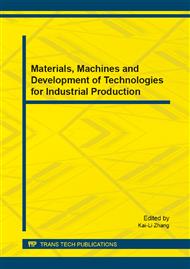p.3
p.8
p.14
p.19
p.24
p.28
p.33
p.39
Effect of Nano-Al2O3 on the Microstructure and Properties of ZrO2 Dental Materials Prepared by Microwave Sintering
Abstract:
Al2O3(x)/ZrO2 composite ceramics were successfully prepared by microwave sintering. The influence of variety content of nanoAl2O3 on mechanical properties and microstructure of ZrO2 dental materials were studied, and analysied the mutual relations of chemical composition, mechanical properties and microstructure to investigate the reason of strengthening and toughening. Results indicated that The relative density of the Al2O3(x)/ZrO2 composite ceramics reached more than 96.8%.The HV hardness ,bending strength and fracture toughness presented excellent mechanical properties as 12.5GPa, 753.8MPa and 11.8MPa·m1/2 with the content of nanoAl2O3 was 7.5%. Compared with that of pure ZrO2 ceramics, the bending strength and the fracture toughness were improved 19% and 96%, respectively. The main crystal phases in this composite ceramics were t-ZrO2 and α-Al2O3.The nanoAl2O3 have a obvious effect on the strength and toughness of ZrO2 based ceramics. The reason of strengthening and toughening mainly the additions reduced the ZrO2 grains growth and promoted grains size uniformity, and changed the fracture mode from transgranular fracture to intergranular fracture characteristics.
Info:
Periodical:
Pages:
3-7
Citation:
Online since:
August 2014
Authors:
Keywords:
Price:
Сopyright:
© 2014 Trans Tech Publications Ltd. All Rights Reserved
Share:
Citation:


